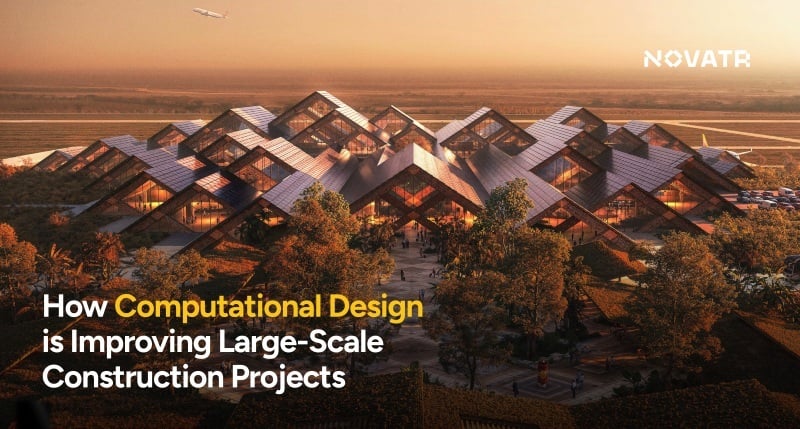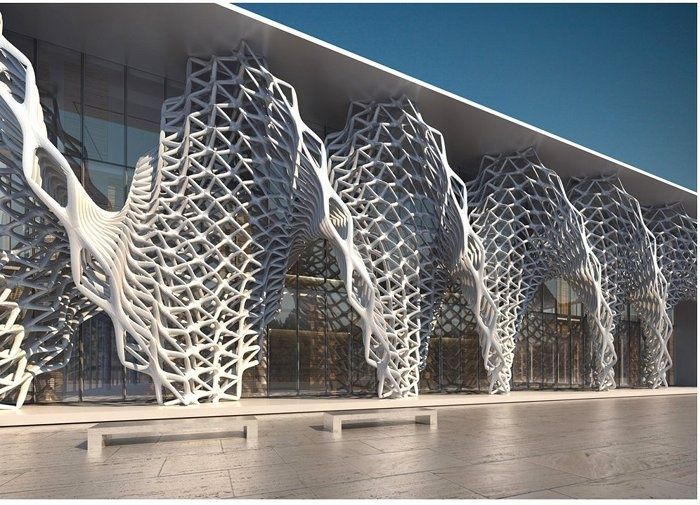How Can Computational Design and Artificial Intelligence Benefit Building Redevelopment Projects?

Table of Contents
Building redevelopment projects are significant from the perspective of urban development and neighbourhood rejuvenation. They play a crucial role in transforming existing structures and spaces to meet evolving needs, foster sustainable practices, and enhance the overall quality of life in cities. Additionally, redevelopment projects promote efficient land use and densification, reducing urban sprawl and preserving open spaces. They also offer socio-economic benefits by attracting investment, generating employment opportunities, and revitalizing local communities. According to a study by the Urban Land Institute, redevelopment projects have a significant economic impact. On average, for every dollar invested in a redevelopment project, there is an economic return of $2.23 in the form of increased property values, job creation, and tax revenue.
Why are Redevelopment Projects Challenging?
While building construction and infrastructure projects are already complex, the project stakeholders take many points into consideration for redevelopment projects. The aspects of demolition, structural assessment, stakeholder interests, occupant relocation, and regulatory permissions are challenging. Additionally, architects and engineers heavily rely on manual processes and traditional tools that further reduce the speed and quality of work. To overcome these issues, technology can be of great help. Let’s have a look at the new-age innovations that make working on redevelopment projects easier and smarter.
Computational Design in Architecture

What is Computational Design?
Computational Design is a digital approach that leverages computational tools and algorithms to inform and enhance architectural design and construction processes. It involves the use of software, scripting languages, and digital modelling techniques to create, analyse, and optimise built solutions.
By leveraging parametric modelling, generative algorithms, and advanced simulation techniques, computational design allows architects to analyse, visualise, and maximise design functionality. This iterative design process enables overall optimisation of the design, thereby enhancing building performance, maximising space utilisation, and improving structural efficiency. Additionally, computational design facilitates the integration of various design parameters, such as environmental factors, material properties, and user preferences, resulting in sustainable and user-centric designs.
Read: How Is Computational Design Used in Architecture in 2023
Types of Computational Design
Computational design is evolving and changing with the development of technology. From the current stance, three different types of Computational Design includes:
- Parametric Design: Parametric Design makes use of parameters and a set of rules to create easily modifiable design solutions.
- Algorithmic Design: Algorithmic Design uses algorithms to generate a design model.
-
Generative Design: Generative Design utilizes algorithms to create a batch of design options open to assessment.
Benefits of Computational Design for Redevelopment Projects
Computational Design has become a significant tool for designers across the globe. Right from form finding to design thinking and construction management, computational design is lending great help to the construction domain. According to a case study conducted by the University of Cambridge, parametric design techniques in redevelopment projects can reduce design time by up to 40% by automating repetitive tasks and enabling rapid iteration and optimization of design parameters. Let’s have a look at how redevelopment projects can be enhanced through the use of computational design.

1. Optimized Design Exploration
Through parametric modeling and algorithmic workflows, designers can quickly generate and evaluate numerous design ideas. Such a computational process allows for a thorough analysis of various factors influencing the built environment, such as building performance, spatial organization, and user experience. This enables architects to identify optimal design solutions that maximize functionality, aesthetics, and efficiency.
2. Data-Informed Decision Making
By employing simulations and analysis tools, architects and engineers can assess the functional performance of proposed design solutions, evaluate energy consumption, conduct structural analyses, and analyze daylighting and ventilation strategies. This data-driven approach empowers professionals to make informed decisions that result in more sustainable, resilient, and cost-effective redevelopment projects.
3. Enhanced Collaboration and Coordination
Computational design fosters seamless collaboration and coordination among multiple project stakeholders. With the use of digital tools and parametric models, teams can effectively share design information, visualize concepts, and streamline communication. This collaborative approach promotes greater integration of expertise, reduces conflicts, and ensures a more cohesive and successful redevelopment process.
4. Efficient Resource Utilization
The use of computational design allows architects to optimise resource allocation and utilisation in redevelopment projects. With algorithms and performance-driven design methodologies, architects can determine the most efficient allocation of materials, space, and energy. This leads to reduced waste, enhanced resource efficiency, and improved sustainability. It can also allow for the exploration of adaptive reuse strategies, maximising the value and potential of existing structures while minimising environmental impact.
5. Streamlined Documentation and Visualization
The process of building documentation can be simplified and automated through computational design tools. By auto-generating accurate drawings, schedules, and specifications based on the design model, architects can save much time, effort, and money, Furthermore, advanced visualization capabilities, including 3D modeling, rendering, and virtual reality simulations, enable architects to effectively communicate their design concepts to clients, stakeholders, and the community.
Artificial Intelligence in Architecture

What is Artificial Intelligence?
Artificial Intelligence (AI) refers to the field of computer science that focuses on creating intelligent machines capable of mimicking human cognitive abilities. AI enables computers to process and analyze vast amounts of data, recognize patterns, and make decisions or predictions based on that information.
AI algorithms excel at identifying patterns, trends, and correlations in vast amounts of data, optimizing resource allocation, and enhancing overall project efficiency. Further, the use of AI in the construction industry facilitates intelligent resource management by monitoring energy consumption, waste management, and infrastructure maintenance, leading to cost savings and promoting sustainability. AI-powered surveillance and predictive modeling can help architects enhance safety and security by proactively identifying and mitigating risks.
Use of AI technology in redevelopment
AI algorithms and tools are valuable for analyzing and predicting costs and project deadlines precisely. Manual cost and time estimations can be calculated inaccurately and the financial repercussions can be detrimental. AI systems like deep learning (mimics the human brain by creating models and statistics), Building Information Modeling, etc. creates models and other stats that can lead to efficient timelines and cost predictability in a construction project.
Also Read: Uncovering the Significant Role of BIM in Constructing the Fehmarnbelt Tunnel
Benefits of Artificial Intelligence for Redevelopment Projects
As the usage of AI for construction increases, it will help speed up the design and build process while allowing the industry to save time and money. According to a study by McKinsey, AI-based predictive analytics can improve construction project productivity by up to 50% through accurate forecasting of project timelines, cost estimation, and identification of potential risks. Let’s have a look at how AI in construction is benefiting redevelopment projects.

1. Resource Optimization
In redevelopment projects, resource optimization is crucial to achieving sustainability and cost efficiency. To achieve this, AI can play a vital role by monitoring and analyzing factors such as the building’s energy consumption, waste management, and infrastructure maintenance. In addition, AI algorithms can process real-time data from smart meters, sensors, and monitoring systems to identify patterns and trends, allowing for more accurate resource allocation.
2. Safety and Security Enhancement
AI-driven systems enhance occupant safety by utilising intelligent surveillance and predictive modelling. With the help of advanced computer vision techniques, AI algorithms can analyse video feeds from security cameras in real-time, detecting and alerting potential safety hazards. Moreover, AI can integrate data from various sensors to monitor indoor environmental factors such as air quality and temperature, ensuring a resilient and comfortable space.
3. Streamlined Construction Processes
AI brings automation to construction tasks, thus optimizing and streamlining the end-to-end process. Robotics and autonomous vehicles can be deployed for tasks such as excavation, material transportation, and assembly, improving productivity and reducing labor costs. Further, AI-powered algorithms can assist in quality control by analyzing sensor data and images to detect any deviations from working drawings, ensuring adherence to high-quality standards.
4. Intelligent Data Analysis and Prediction
With the use of AI algorithms, designers can analyze data such as historical records, user feedback, environmental conditions, and socio-economic indicators. By uncovering hidden patterns and correlations within the data, AI can provide valuable insights for decision-making. For instance, AI can predict future infrastructure demands, allowing planners to allocate resources effectively and anticipate future needs.
5. Informed Decision-Making
AI empowers planners and decision-makers by providing accurate insights derived from comprehensive data analysis. By analyzing vast amounts of information, AI algorithms can identify patterns, trends, and correlations that may go unnoticed by humans. This enables informed decision-making, ensuring that redevelopment projects are guided by data-driven strategies, resulting in more efficient use of resources and improved outcomes.
3 Noteworthy Examples of Artificial Intelligence in Construction
International companies are now embracing computational design and artificial intelligence to accelerate their project construction and achieve design optimization. Here are some prominent examples of building redevelopment projects where these technologies have been used.
1. The Spheres, Seattle, USA

The Spheres, located in Seattle, USA, were redeveloped as a part of Amazon's headquarters expansion. Completed in 2018, the project aimed to create a unique workspace that integrates nature with the working environment. Computational design played a crucial role in the construction of the spherical glass structures. The design team utilized parametric modeling techniques to optimize the complex geometry and structural integrity of the domes. This streamlined the design process and allowed for efficient distribution of the glass panels and ensured optimal transparency and light transmission. Additionally, artificial intelligence-driven climate control systems were implemented to maintain the ideal temperature, humidity, and light levels for the extensive plant life within the Spheres.
2. The Edge, Amsterdam, Netherlands

The Edge, a sustainable office building in Amsterdam, underwent redevelopment and was completed in 2015. It employed computational design and artificial intelligence to create an energy-efficient and smart working environment. The building's design, led by PLP Architecture and OVG Real Estate, utilised parametric modelling to optimise the building's layout, lighting, and spatial organisation. This resulted in a dynamic and flexible workspace that maximises natural light and offers comfortable working conditions. Furthermore, artificial intelligence-driven systems analyse real-time data from sensors throughout the building to optimise energy usage, lighting, and indoor climate control. This allows for personalised and responsive built environmental conditions for occupants while reducing energy consumption.
3. The Royal Opera House, London, United Kingdom

The redevelopment of The Royal Opera House in London took place in multiple phases, with the latest completed in 2018. Computational design and artificial intelligence played a significant role in improving the performance capabilities and audience experience. In collaboration with Stanton Williams and BAM Construction, the project utilised computational design techniques to optimise the acoustics, seating arrangements, and stage configurations. Advanced digital tools and AI algorithms were employed to simulate and analyse the acoustic properties, ensuring optimal sound distribution and clarity. This resulted in an enhanced and immersive theatrical experience for the audience while preserving the architectural heritage of the iconic venue.
In Conclusion
As we embrace computational design and artificial intelligence in building redevelopment projects, we unlock the potential for creating transformative urban environments that are sustainable, efficient, and conducive to the needs of communities. By harnessing the power of these technologies, we can shape the future of cities and create spaces that inspire, connect, and enrich the lives of those who inhabit them.
Also Read: The Giant Cost of Hiring For BIM Roles And How to Minimise It
If you too want to be a part of meaningful redevelopment interventions, you must upskill in such future-relevant technologies. You can learn them by enrolling on the Master Computational Design Course offered by Novatr. The course offers you the opportunity to learn in-depth about computational design processes, tools, and workflows. Check out the course TODAY!

 Thanks for connecting!
Thanks for connecting!

.png)


.jpg)


%20(1).jpg)
